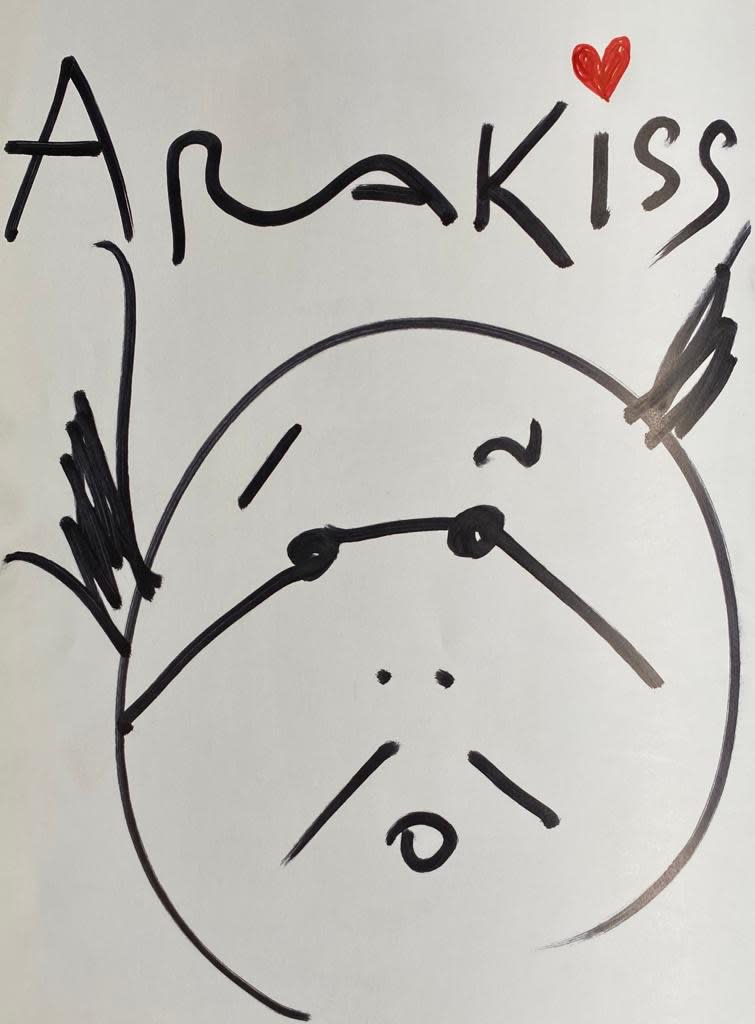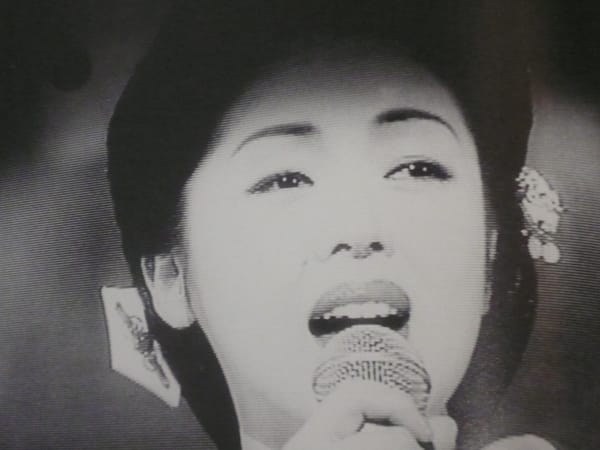Searching a grid of mailboxes for Araki’s name in the anonymous lobby of a Tokyo apartment complex felt dangerously close to trespassing. I had been invited to meet him for the first time at this address, but the beige hallway seemed an unlikely choice for an artist who has courted controversy so flamboyantly throughout his career.
-
Through an unmarked door on the third floor, I found myself in the twilight ambience of a cavernous concrete chamber. Neon underlighting from beneath a narrow lacquer walkway guided me in. The walls were closely hung with dense constellations of photographs, broken up by towering bouquets left over from an opening night. I remembered Araki’s description of how flowers are enriched with life as they approach death, and his desire to capture their fleeting sensuality.
-
As my eyes became accustomed to the gloomy gallery — steeped in Araki’s iconography to the point of self-parody — I spotted a swinging boom microphone. I realised that I had walked onto the set of a televised interview with the artist, whose gales of laughter and entendre-laden welcome indicated that he was definitely in on the joke. Conspiratorially he drew up a chair, and we began our formal introductions as the cameras rolled.
-
TOKYO
-

-
Bottles of whiskey bearing his signature scrawl of moustache and spectacles are displayed in bars on the shelves reserved for particularly legendary patrons. For years Araki hosted ‘salons ’in the trendy satellite suburb of Shimokitazawa, where hordes of photography enthusiasts, wannabe models and amused spectators queued for blocks to meet him. He could often be spotted combing through boxes in the antique shops of Nishi-Ogikubo, on the hunt for the dolls and tiny reptiles which feature so frequently in his compositions whilst waiting for the karaoke parlours to open.
-
-
Tokyo has been the subject of many of Araki’s books and the backdrop to nearly all of them (around 500 to date). Photographs from his student days reflect the ramshackle reality of life in Tokyo after the war. Following schoolboys around the ruined shitamachi – a tangle of old-fashioned neighbourhoods at Tokyo’s heart — these pictures already illustrate Araki’s fascination with life and aliveness, humour and human interaction, intensified by the bleakness of the postwar landscape.
-
Whilst still employed at an advertising agency, Araki began to dispatch random, often obscene, prints to unsuspecting addresses plucked out of the phonebook. Today these prints might be described ‘mail art’, but Araki’s increasingly audacious challenges to Japan’s obscenity laws quite literally pushed the envelope hard into the homes of ordinary citizens. He began sending in pictures to amateur camera magazines, winning the attention and respect of his peers including Tōmatsu Shōmei, Hosoe Eikoh, Moriyama Daidō, and Fukase Masahisa, with whom he led the Photo Workshop School throughout the 1970s.
-

-
He coined the term shi-shashin (‘I-photography’) in homage to Japan’s tradition of confessional literature, which seeks to triangulate existential experience, abstract truth and art. The photography which emerges from this volatile concoction testifies to a powerful and devoted subjectivity, focalising a kind of art which goes beyond performance or narration to express something more instinctual. Whether inviting us to join his sleeping wife aboard their honeymoon voyage or leading us through Shinjuku’s bondage clubs and love hotels, Araki’s relentless honesty can be as controversial as it is compelling.
When he celebrated his 80th birthday earlier this month, I was reminded of the freshness of Araki’s unreconstructed candour, as brazen and iconoclastic on an October afternoon in 2018 as when he first burst onto the scene more than half a century ago. Long live the ‘photo-mad old man!'
-
TEXT BY Lucy Fleming-BrowN
Lucy FLEMING-BROWN is the gallery's resident Japanologist. She studied Japanese at Oxford University and travels regularly between London and Tokyo. Her research interests lie with post-war Japanese photography and experimental arts.
-
FEATURED WORKS BY NOBUYOSHI ARAKI
MORE WORKS AVAILABLE -
AVAILABLE WORKS
-
Araki discusses 'A Sentimental Journey' (picture above)
Video credit: SFMOMA -
FEATURED FLOWER RONDEAU
-
AVAILABLE WORKS
-
If you would like to see more of Araki's work, please email us at
gallery@michaelhoppengallery.com
FULL PRICE LIST OF WORKS FROM THIS VIEWING ROOM: HERE
Header image © Juan Jerez. Installation from Araki's 2016 Retrospective at Musée Guimet, Paris -
























